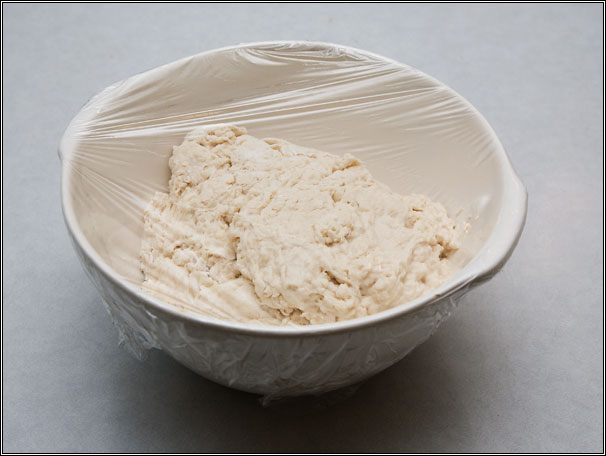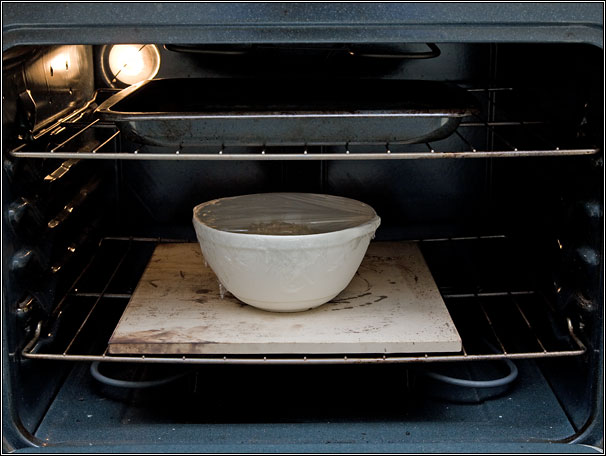
source: http://epaperpress.com/recipes/bread.html
This recipe is a variation of Pain à l'Ancienne (old fashioned bread) that appeared in The Bread Baker's Apprentice, by Peter Reinhart. I've taken his recipe one step further to optimize the natural sweetness of the loaf.
No sweetener is used in this recipe but instead relies on cold fermentation so that enzymes to break down complex carbohydrates in the dough to simple sugars. A temperature of about 40° F is maintained to prevent the yeast from consuming sugars developed by enzymes. The net result is a loaf with superb natural sweetness. Very little kneading is required.
Reinhart's recipe calls for heating the oven to 550° F (if possible) and then reducing the temperature to 475° F. In my setup this does a nice job of turning the bottom crust to charcoal. Baking at 400° F for the entire time solved the problem. Baking time was increased from 25 to 40 minutes and no spraying is necessary since water in the pan has a chance to boil before the dough starts to rise. Two cups of water, rather than one cup, were used for steam. Keeping the dough moist for a longer period resulted in a softer crust that is good for sandwich bread.
This page is also available as a PDF document.
Equipment
The following equipment is needed:
- pizza stone
- pizza peel
- oven pan
- parchment paper
- one large bowl, one small bowl
- paper bag
- dough scraper
- kitchen scales that measure to the nearest gram
- small strainer
Ingredients
Only four ingredients comprise this loaf:
Flour. White bread flour, either bleached or unbleached. I purchase 50 pound bags of white bread flour from Costco. Over the years I've found it to be consistent and rises well.Professional bakers specify ingredients by weight. This is especially recommended for flour as it can easily fluff-up or compress rendering volume measurements inaccurate. Kitchen scales are inexpensive and highly recommended. In bread recipes flour counts as 100% and the remaining ingredients are based on this value.
Water. The water must be ice cold (approximately 40° F). I store drinking water, in gallon jugs, in the refrigerator and this works fine.
Salt. Standard table salt works fine.
Yeast. Any brand of instant yeast will do just fine. But if you bake a lot of bread purchase a 16oz packet of SAF Instant Yeast (red label). Check your local supermarket (WinCo has it for $3) or purchase online. Store in an airtight container in the freezer and it will last for years.
Reinhart recommends the percentages shown in the table below. For salt and yeast I use volume measurements after confirming that they yield the correct weight. For consistency and accuracy I load up the measuring spoon and then level it off with a knife.
Ingredient Percent Weight Volume Flour 100 640g Water 79.6 510g Salt 2 13g 2 tsps Yeast 0.7 5g 2 tsps
The recipe calls for approximately a 24 hour stay in the refrigerator. At 24 hours the dough is mildly sweet and delicious. Less than 24 hours the dough is a bit salty; more than 24 hour it ferments and becomes sour. When removed from the refrigerator the dough must be brought to room temperature and allowed to rise as quickly as possible. This prevents the yeast from excessive activity that will destroy the natural sweetness created by the enzymes. To achieve this feat a warm oven is utilized.
The Day Before
Place a large bowl on scales and add the flour. Then add yeast and salt. Mix thoroughly with a whisk. Zero-out the scales and add water until the correct weight is achieved. Mix the dough thoroughly with a sturdy spoon until the dough is firm and forms a cohesive ball. After mixing is complete transfer the dough to a small bowl, cover the bowl with plastic wrap, and store in the refrigerator for 24 hours.
The Next Day
The goal is to warm-up the dough from 40° F to 80° F, and form it into a loaf, all within two hours. First remove the bowl from the refrigerator, puncture the plastic wrap with a fork to allow the dough to expand, and let it set at room temperature for one hour to take the chill off the dough. During this time prepare the oven by placing a pizza stone on the lowest rack and an oven pan, to hold water, on the top rack.
After one hour preheat the oven to 200° F. After the oven comes to temperature place the bowl in the oven. When the dough doubles in size (approximately 40 minutes) remove it from the oven and allow to cool for 20 minutes so it is easy to handle.
Forming
Turn on the oven and set the temperature to 400° F. While the oven is coming to temperature proceed as follows. Cover the pizza peel with a sheet of parchment paper. Cover the counter top with a light layer of flour by sifting it through a small strainer. Remove the plastic wrap from the bowl and use a dough scraper to place the dough onto the floured surface
With floured hands stretch the dough out to a square shape, fold it left-to-right, and fold it again from top-to-bottom. With the heel of your hand push out the dough, fold it over, rotate 90 degrees, and push out again. Repeat this procedure three or four times. Keep sprinkling more flour as needed. This bit of kneading will firm-up the loaf so it will keep its shape during baking. After shaping the dough rapidly tuck in the bottom edges several times (palm up) so that the surface is taut and place dough on parchment paper.
Let the dough rest for the additional 10–20 minutes required for the oven to come up to temperature. This second rest period allows the gluten to relax and ensures the bottom portion will rise along with the rest of the dough. If you measure the temperature in the center of the dough it should read 80–85° F.
Baking
After the oven comes up to temperature add two cups of hot tap water to the pan. Slide the parchment paper from the peel to the stone. Bake for 25 minutes, rotate the loaf 180°, then bake for 15 more minutes so it browns evenly. As my oven does not have a precise temperature control I go more by loaf color than exact time.
The lower 2/3 of the loaf should exhibit some browning on all sides.
Remove the loaf from oven, place it in a paper bag, and set the bag on a rack to cool. Now comes the hard part. Wait 2 hours before slicing to allow the natural sweetness to fully develop.
tl;dr
Previous day
- Combine 640g flour, 2 tsps yeast, and 2 tsps salt with a whisk
- Add 510g water and combine with a sturdy spoon
- Refrigerate for 24 hours
Baking day
- Remove from refrigerator and let set one hour
- Heat oven to 200° F and turn off
- Place bowl in oven for 40 minutes
- Remove bowl from oven and let set for 20 minutes
- Place a sheet of parchment paper on pizza peel
- Form into loaf and place on parchment paper
- Heat oven to 400° F, add 2 cups of water to the pan, and slide loaf into oven
- Bake for 25 minutes
- Rotate and bake for another 15 minutes
- Remove from oven and let cool for 2 hours in a paper bag
After a while all you'll need to remember is this:
60 minutes: room temp
40 minutes: 200°
20 minutes: room temp
25 minutes: 400°
15 minutes: rotate
A Few Tips
When warming the dough be sure to leave the plastic wrap on the bowl until you are ready to form the loaf. Removing the plastic wrap too early allows the surface to dry and can create small hard nuggets.
In Reinhart's book he periodically sprays the oven walls with water at the beginning of the baking cycle. By adding hot water to the oven pan no spraying is needed.
Baking time is critical. Too long and you'll bake-out the moisture. Too short and you'll be left with moist unbaked portions at the top of the loaf. Bake just long enough so that there are no moist bits, but no longer, and you'll have a soft loaf. Some experimenting will be necessary to determine this time and it may vary with the seasons as kitchen temperatures change. I've also found that the temperature in my oven is higher at the back of the oven. As a consequence I examine the color after I rotate the loaf and adjust the time for the second part as needed.
This bread goes especially well with Partanna Extra Virgin Olive Oil. If you have children then the loaf will be gone the same day. Otherwise slice the loaf, cut each slice in half, and freeze in a freezer bag. To thaw place individual slices in a toaster for a bit and then finish thawing in a microwave.






Niciun comentariu:
Trimiteți un comentariu